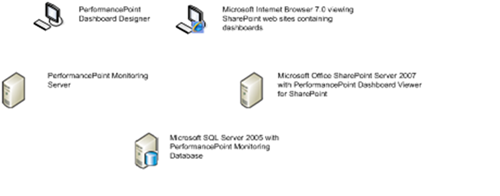Monitoring Server Scalability Tips
A number of Microsoft server products have offered prescribed deployment topologies - dictating the exact component topology for a single box, small farm, medium farm and large farm configurations. Performance Point Monitoring Server has three points of interest when scaling out.
Monitoring Scaling points of interest:
· Dashboard requests are load balanced across the Dashboard Viewer web part and MOSS 2007 Farms
· Dashboard Viewer web part contains Monitoring web services that are needed to render dashboard. Does not contain all the Monitoring web services.
· The Monitoring Server repository can be an issue for web server scaling. The size of the temporary object table can be quite large for high bandwidth farms.
· Dashboard Designer requests are load balanced across the Monitoring Server
· As appropriate user requests are handled by the Monitoring Server which communicating directly to SQL Server relational databases, SQL Server Analysis Services, and all supported data source.
· Dashboard elements send queries to data source such as SQL Server Analysis Services. These data sources may need to be scaled out as well.
· SQL Server Analysis Services receives queries from the dashboard. if you have 10,000 users requesting dashboard that is a lot of queries being sent to SQL Server Analysis services. These data sources may need to be scaled out as well.
· Caching is key factor in supporting large user loads, and the choice of data security models has a dramatic effect on cache effectiveness. PerformancePoint 2007 Monitoring Server is capable of achieving very high cache rates when using Application Security. In contrast, User Security can place a large burden on the data source back end.
.
Monitoring Server - system diagrams
The diagram is a simple Monitoring Server topology. There two clients, the Dashboard designer and the web browser viewing dashboards. There are two middle tier servers, the PerformancePoint Monitoring Server which is where dashboard designer communicate to create dashboards and the Microsoft Office SharePoint Server 2007 with the PerformancePoint Dashboard Viewer for SharePoint which is where the web browser views the dashboards from. There is one back end server, the Monitoring Server System Database resides on SQL Server 2005 SP2 server.
Both the middle tier servers can be network load balanced and can grow to accommodate the user demand. The Monitoring Server System database can reside in a SQL cluster to improve performance as well. The data sources for the dashboard could be scaled based on the technology but efficient caching of the queries to the data sources is the best way to remove the need to scale data sources.
